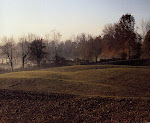...born in Newcastle in 1928. In his series of works depicting the landscape and wildlife of Australia he has produced some of the most iconic images in Australian art. John Olsen is also a highly accomplished printmaker.
Judy Watson
...A direct descendant of the Waanyi clan, Watson was born in 1959 at Mundubbera in the coastal hinterland of Queensland
...A direct descendant of the Waanyi clan, Watson was born in 1959 at Mundubbera in the coastal hinterland of Queensland
Her prints have an ethereal quality: mystical figures, caught in a spindrift; their form is unclear; a swirling, spiritual mirage.

Mandy Martin
...Mandy Martin, born 1952 in Adelaide, is a practising artist who has held more than 110 solo exhibitions in Australia, Mexico and the USA. She has exhibited widely in curated exhibitions in Australia, France, Germany, Japan, Taiwan, USA, and Italy. Her works are in many public and private collections including the National Gallery of Australia and major state galleries and collections.
Fred Williams
...Australian painter and printmaker. He was one of Australia’s most important artists, and one of the twentieth century’s major painters of the landscape.
...Australian painter and printmaker. He was one of Australia’s most important artists, and one of the twentieth century’s major painters of the landscape.
Tim Storrier
...Tim Storrier was born in Sydney in 1949. At the age of nineteen, Storrier won the prestigious Sulman Prize. He was the youngest artist to ever receive the award and hence catapulted to fame and success at an early age.


Lloyd Rees
...Most of his works are preoccupied with depicting the effects of light, and emphasis is placed on the harmony between man and nature. Rees' oeuvre is dominated by sketches and paintings, in which the most frequent subject is the built environment in the landscape.






>My favourite of these artists are Lloyd Rees, John Olsen, and Fred Williams.
I really like the different ways in which the artworks had been painted and how they all give a different feeling. I like the way that John Olsen uses simple lines to create an image, all his artworks look simple and delicate.
I think that Fred Williams also does a bit of this as well, although he uses lots of different colours which look really interesting.
Finally, Lloyd Rees' paintings looks really nice. His use of colour and line are very nice. He paints many works of stained glass windows. The colours look very nice and calm.




















.jpg)